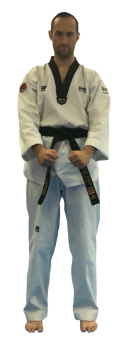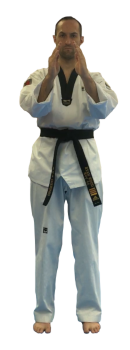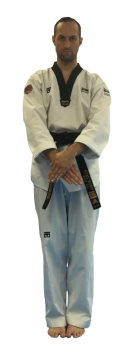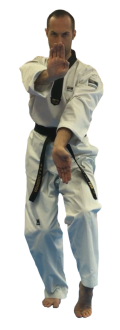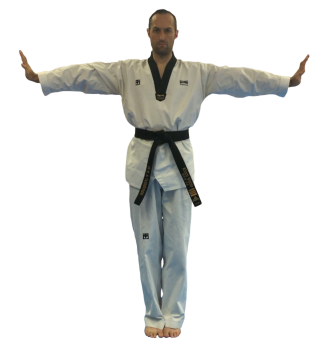Special Techniques & Postures
Teuksupum - 특수품
Small Hinge
Jageun Doljjeogwi
작은 돌쩌귀
“Jahg-Oon Dohl-Chjuh-G’wee”
A preparatory motion for performing attacks and defenses in sequence. In poomsae the top fist is always vertical.
Practically speaking, you are pulling onto the arm of someone across your body while delivering a front foot kicking technique to their knee or body.
Large Hinge
Keun Doljjeogwi
큰 돌쩌귀
“Koon Dohl-Chjuh-G’wee”
A preparatory motion for performing attacks and defenses in sequence. In poomsae the top fist is always horizontal.
Practically speaking, you are holding the wrist or sleeve of an opponent with one hand while securing a grip across their back/lat with the other to prepare a throwing technique.
미덜 가드
Middle Guard
Fighting Posture
Gyeorumsae
겨룸새
“G’yuh-Room-Seyh”
Also called Fighting Stance and 겨루기 준비 서기 Kyorugi Junbi Seogi.
The body position taken when engaged in combat sports or self defense. When the left foot is in front it is called a Left Fighting Stance / 왼 겨룸새 Oen Gyeorumsae (conventionally referred to as “Orthodox”) and when the right foot is in front it is called a Right Fighting Stance / 오른 겨룸새 Oreun Gyeorumsae (conventionally referred to as “South Paw”).
The type of guard (arm position) used will vary depending on the situation.
Some examples:
High Guard 하이 가드
Both fists are held high, knuckles pointing up, with the rear one being placed alongside the jaw. The front arm is bent approximately 90° and both elbows are held against the side of the body, pointing down.Middle Guard 미덜 가드
Both fists are held around chest height, knuckles pointing forward, with the rear arm covering the solar plexus. The front arm is bent approximately 90° and both elbows are pointing down.Low Guard 로 가드
Both fists are held around lower abdomen height, knuckles pointing forward, with both forearms running parallel to the floor. The front arm is bent approximately 90° and both elbows are pointing to the rear.No Guard 노 가드
Often employed in Olympic style competition, the arms are left down in order to bait an attack, add counter-balance to dynamic kicking techniques and to parry or impede the front leg of the opponent, amongst other applications. Only used from a range at which no immediate action from the opponent is possible, meaning they must perform some sort of movement to cover the distance between the two participants prior to delivering a blow.
Double Fist Ready Posture
Du Jumeok Heori Junbi Jase
두 주먹 허리 준비 자세
“Doo Joo-Muhk Huh-Ree Joon-Bee Jah-Say”
Also called Two Fists On The Waist Ready Posture.
A ready posture where both arms reach out at solar plexus level with open palms facing downward before both arms are tightly chambered (the elbow is bent and the Hammer Fist is placed at the side of the hip). When viewed from the front neither elbow should be visible. Typically used before practicing poomsae style techniques while in Riding Stance / Juchum Seogi.
Basic Ready Posture
Kibon Junbi Jase
기본 준비 자세
“Kee-Bohn Joon-Bee Jah-Say”
A ready posture adopted at the beginning and end of most poomsae, used to focus one’s inner and outer self.
Starting from a Closed Stance / Moa Seogi, move the left foot one step to the side to make a Parallel Stance / Naranhi Seogi. Draw the open hands forward to the lower abdomen / danjeon and then up to the level of the solar plexus while inhaling and slowly transfer both fists back to the level of danjeon while exhaling.
Performed over a duration of 5 seconds in poomsae.
Covered Fist Ready Posture
Bo Jumeok Junbi Jase
보 주먹 준비 자세
“Boh Joo-Muhk Joon-Bee Jah-Say”
A ready posture where the right fist is covered by the left hand at the lower abdomen / danjeon level then slowly raised and extended from the body at the philtrum level.
Performed over a duration of 5 seconds in poomsae.
Pushing Ready Posture
Tongmilgi Junbi Jase
통밀기 준비 자세
“Tohng-Meel-Gee Joon-Bee Jah-Say”
Also called Log Pushing Ready Posture. A ready posture where the open hands are lifted with the palms facing one another from the lower abdomen / danjeon up to the philtrum before pushing slightly forward. Fingers should be gently curved with the thumbs folded alongside the hands.
Performed over a duration of 5 seconds in poomsae.
Application: Using both hands to push against the face of an aggressor, possibly while using the fingertips to rake their eyes.
Overlapped Hands Ready Posture
Gyeopson Junbi Jase
겹손 준비 자세
“G’yuhp-Sohn Joon-Bee Jah-Say”
A ready posture where the palm of the left hand overlaps the back of the right hand at the lower abdomen / danjeon level.
Performed over a duration of 5 seconds in poomsae.
Application: To stand like Steven Seagal. I mean — one interpretation is securing a double collar tie neck clinch on an opponent before pulling their head down to deliver a knee strike.
Mountain Push
Taesan Milgi
태산 밀기
“Teyh-Sahn Meel-Gee”
The poomsae motion of pushing against someone who is as rooted as a mountain. The top Palm Heel should be at philtrum level with the bottom Palm Heel being at lower abdomen level.
Not a Kamehameha or Hadouken, unfortunately.
Performed over a duration of 5 seconds in poomsae.
Application: An explosive push against the face and abdomen of an aggressor.
Rock Push
Bawi Milgi
바위 밀기
“Bah-Wee Meel-Gee”
Sometimes translated as Boulder Push. The poomsae motion of pushing against someone who is firm as a rock.
Performed over a duration of 5 seconds in poomsae.
Application: An explosive push against the face and chest of an aggressor, paired with a push of the rear leg and step of the front leg to create a large amount of forward force.
Wing Spread
Nalgae Pyeogi
날개 펴기
“Nahl-Geyh P’yuh-Gee”
A poomsae motion where overlapped hands are lifted up from the danjeon to the shoulders before separating with the palms pushing outward and the fingertips pointing upward.
Performed over a duration of 5 seconds in poomsae.
Application: Swiftly lifting one’s arms inside the two handed grasp of an aggressor before sharply pressing outward in order to make enough space to counter grapple and/or strike from the clinch.
Lift Up
Kkeuleo Olligi
끌어 올리기
“Kool-Uh Ohl-Lee-Gee”
Also known as Upward Tripping Block / 올려 걸어 막기 / Ollyeo Georeo Makgi.
A motion where the inner forearm is used with upward force against a limb of an opponent such as the back of the elbow or, after catching a Front Kick, against the Achilles tendon.






